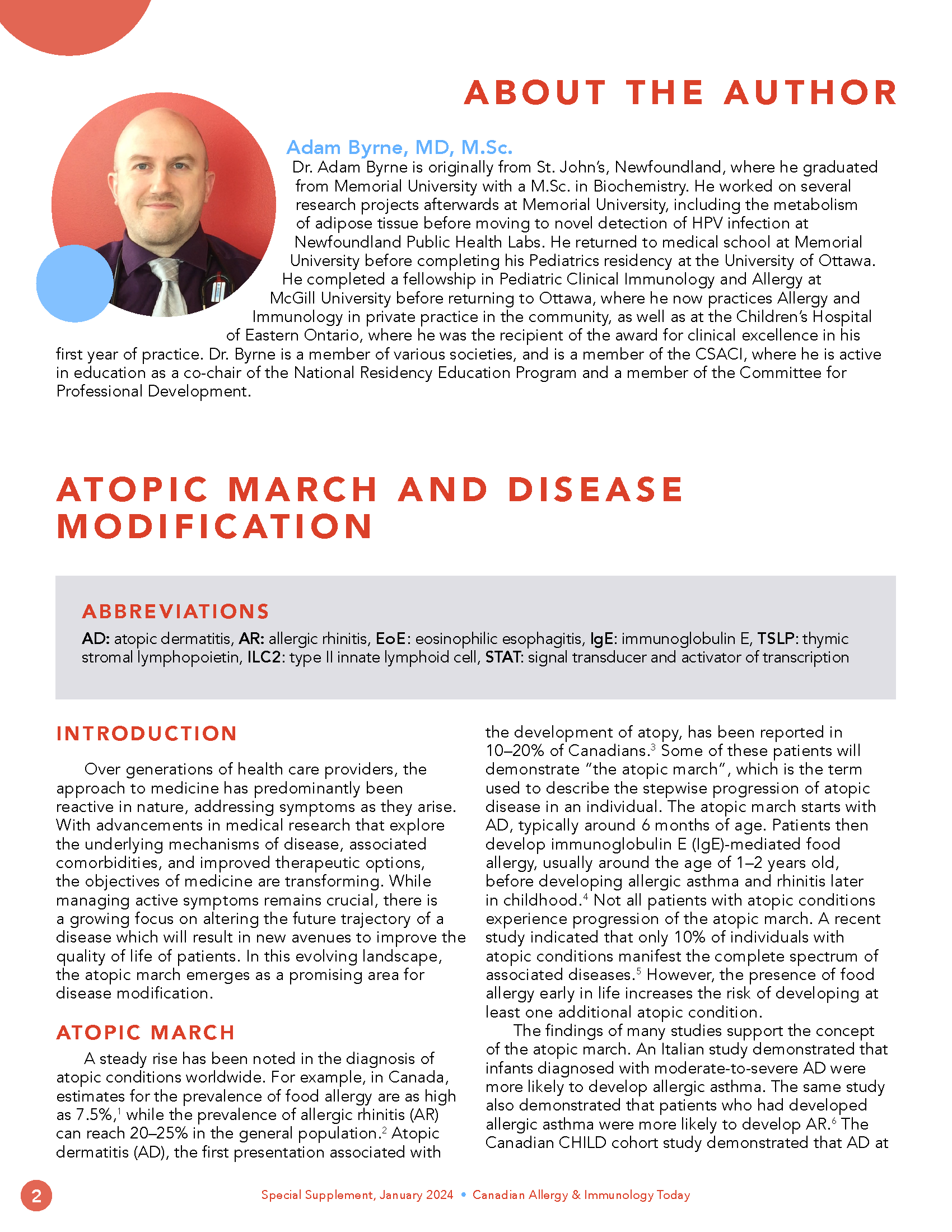Atopic March and Disease Modification
DOI:
https://doi.org/10.58931/cait.2024.4s0160Abstract
Over generations of health care providers, the approach to medicine has predominantly been reactive in nature, addressing symptoms as they arise. With advancements in medical research that explore the underlying mechanisms of disease, associated comorbidities, and improved therapeutic options, the objectives of medicine are transforming. While managing active symptoms remains crucial, there is a growing focus on altering the future trajectory of a disease which will result in new avenues to improve the quality of life of patients. In this evolving landscape, the atopic march emerges as a promising area for disease modification.
References
Soller L, Ben-Shoshan M, Harrington DW, Knoll M, Fragapane J, Joseph L, et al. Adjusting for nonresponse bias corrects overestimates of food allergy prevalence. J Allergy Clin Immunol Pract. 2015;3(2):291-293.e292. doi:10.1016/j.jaip.2014.11.006
Keith PK, Desrosiers M, Laister T, Schellenberg RR, Waserman S. The burden of allergic rhinitis (AR) in Canada: perspectives of physicians and patients. Allergy Asthma Clin Immunol. 2012;8(1):7. doi:10.1186/1710-1492-8-7
Lynde C, Barber K, Claveau J, Gratton D, Ho V, Krafchik B, et al. Canadian practical guide for the treatment and management of atopic dermatitis. J Cutan Med Surg. 2005;8 Suppl 5:1-9. doi:10.1007/s10227-005-8080-3
Hill DA, Grundmeier RW, Ramos M, Spergel JM. Eosinophilic Esophagitis is a late manifestation of the allergic march. J Allergy Clin Immunol Pract. 2018;6(5):1528-1533. doi:10.1016/j.jaip.2018.05.010
Alduraywish SA, Standl M, Lodge CJ, Abramson MJ, Allen KJ, Erbas B, et al. Is there a march from early food sensitization to later childhood allergic airway disease? Results from two prospective birth cohort studies. Pediatr Allergy Immunol. 2017;28(1):30-37. doi:10.1111/pai.12651
Ricci G, Patrizi A, Baldi E, Menna G, Tabanelli M, Masi M. Long-term follow-up of atopic dermatitis: retrospective analysis of related risk factors and association with concomitant allergic diseases. J Am Acad Dermatol. 2006;55(5):765-771. doi:10.1016/j.jaad.2006.04.064
Tran MM, Lefebvre DL, Dharma C, Dai D, Lou WYW, Subbarao P, et al. Predicting the atopic march: results from the Canadian Healthy Infant Longitudinal Development Study. J Allergy Clin Immunol. 2018;141(2):601-607.e608. doi:10.1016/j.jaci.2017.08.024
Kijima A, Murota H, AyaTakahashi, Arase N, Yang L, Nishioka M, et al. Prevalence and impact of past history of food afllergy in atopic dermatitis. Allergol Int. 2013;62(1):105-112. doi:10.2332/allergolint.12-OA-0468
Hirota T, Nakayama T, Sato S, Yanagida N, Matsui T, Sugiura S, et al. Association study of childhood food allergy with genome-wide association studies-discovered loci of atopic dermatitis and eosinophilic esophagitis. J Allergy Clin Immunol. 2017;140(6):1713-1716. doi:10.1016/j.jaci.2017.05.034
Yang L, Fu J, Zhou Y. Research progress in atopic march. Front Immunol. 2020;11:1907. doi:10.3389/fimmu.2020.01907
Hill DA, Spergel JM. The atopic march: critical evidence and clinical relevance. Ann Allergy Asthma Immunol. 2018;120(2):131-137. doi:10.1016/j.anai.2017.10.037
Tham EH, Leung DY. Mechanisms by which atopic dermatitis predisposes to food allergy and the atopic march. Allergy Asthma Immunol Res. 2019;11(1):4-15. doi:10.4168/aair.2019.11.1.4
Du Toit G, Roberts G, Sayre PH, Bahnson HT, Radulovic S, Santos AF, et al. Randomized trial of peanut consumption in infants at risk for peanut allergy. N Engl J Med. 2015;372(9):803-813. doi:10.1056/NEJMoa1414850
Upton JEM, Correa N, Eiwegger T. Oral immunotherapy for food allergy: what's age got to do with it? Allergy. 2023;78(3):626-628. doi:10.1111/all.15623
Lowe AJ, Su JC, Allen KJ, Abramson MJ, Cranswick N, Robertson CF, et al. A randomized trial of a barrier lipid replacement strategy for the prevention of atopic dermatitis and allergic sensitization: the PEBBLES pilot study. Br J Dermatol. 2018;178(1):e19-e21. doi:10.1111/bjd.15747
Kelleher MM, Phillips R, Brown SJ, Cro S, Cornelius V, Carlsen KCL, et al. Skin care interventions in infants for preventing eczema and food allergy. Cochrane Database Syst Rev. 2022;11(11):Cd013534. doi:10.1002/14651858.CD013534.pub3
Yamamoto-Hanada K, Kobayashi T, Mikami M, Williams HC, Saito H, Saito-Abe M, et al. Enhanced early skin treatment for atopic dermatitis in infants reduces food allergy. J Allergy Clin Immunol. 2023;152(1):126-135. doi:10.1016/j.jaci.2023.03.008
Alviani C, Roberts G, Mitchell F, Martin J, Zolkipli Z, Michaelis LJ, et al. Primary prevention of asthma in high-risk children using HDM SLIT: assessment at age 6 years. J Allergy Clin Immunol. 2020;145(6):1711-1713. doi:10.1016/j.jaci.2020.01.048
Zielen S, Devillier P, Heinrich J, Richter H, Wahn U. Sublingual immunotherapy provides long-term relief in allergic rhinitis and reduces the risk of asthma: a retrospective, real-world database analysis. Allergy. 2018;73(1):165-177. doi:10.1111/all.13213
Martorano LM, Grayson MH. Respiratory viral infections and atopic development: from possible mechanisms to advances in treatment. Eur J Immunol. 2018;48(3):407-414. doi:10.1002/eji.201747052
Teach SJ, Gill MA, Togias A, Sorkness CA, Arbes SJ, Jr., Calatroni A, et al. Preseasonal treatment with either omalizumab or an inhaled corticosteroid boost to prevent fall asthma exacerbations. J Allergy Clin Immunol. 2015;136(6):1476-1485. doi:10.1016/j.jaci.2015.09.008
Phipatanakul W, Mauger DT, Guilbert TW, Bacharier LB, Durrani S, Jackson DJ, et al. Preventing asthma in high risk kids (PARK) with omalizumab: design, rationale, methods, lessons learned and adaptation. Contemp Clin Trials. 2021;100:106228. doi:10.1016/j.cct.2020.106228
Hamilton JD, Suárez-Fariñas M, Dhingra N, Cardinale I, Li X, Kostic A, et al. Dupilumab improves the molecular signature in skin of patients with moderate-to-severe atopic dermatitis. J Allergy Clin Immunol. 2014;134(6):1293-1300. doi:10.1016/j.jaci.2014.10.013
Matucci-Cerinic C, Viglizzo G, Pastorino C, Corcione A, Prigione I, Bocca P, et al. Remission of eczema and recovery of Th1 polarization following treatment with Dupilumab in STAT3 hyper IgE syndrome. Pediatr Allergy Immunol. 2022;33(4):e13770. doi:10.1111/pai.13770
Martinez-Cabriales S, Marcoux D, Liy-Wong C, Prajapati VH, Sibbald C, Cunningham N, et al. Multicenter Canadian case series of pediatric patients less than 12 years of age with moderate-to-severe atopic dermatitis treated with dupilumab. Pediatr Dermatol. 2023. doi:10.1111/pde.15418
Martinez-Cabriales S, Marcoux D, Liy-Wong C, Prajapati VH, Sibbald C, Cunningham N, et al. Multicenter Canadian case series of pediatric patients less than 12 years of age with moderate-to-severe atopic dermatitis treated with dupilumab. Pediatr Dermatol. 2023. doi:10.1111/pde.15418
Paller AS, Guttman-Yassky E, Irvine AD, Basselga E, de Bruin-Weller M, Jayawardena S, et al. Protocol for a prospective, observational, longitudinal study in pediatric patients with moderate-to-severe atopic dermatitis (PEDISTAD): study objectives, design, and methodology. BMJ Open. 2020; 10:e033507
Geba G, Li D, Mohammadi K, Attre R, Ardeleanu M, Musser B. Attenutating the atopic march: meta-analysis of the dupilumab atopic dermatitis database for incident allergic events. J Allergy Clin Immunol. 2023; 151:757-666

